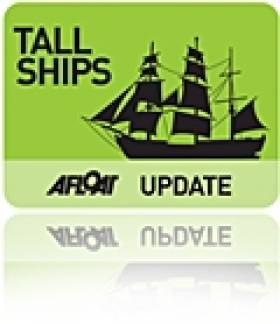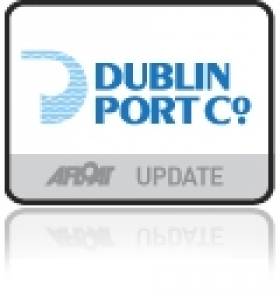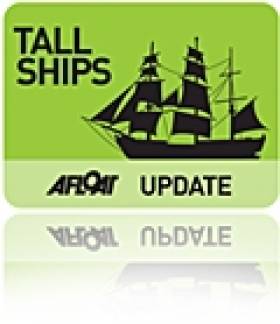Displaying items by tag: Jeanie Johnston
Below the Surface Lecture Series: ‘Norse Dublin - The Fleet of Norse Dublin around 1000AD’
#LectureNorseDublin: The next and final monthly held 'Below the Surface' lecture the "Norse Dublin - The Fleet of Norse Dublin around 1000AD" is to be held on Wednesday 3 April (starting 8pm).
The talk to be presented by Professor Poul Holm TCD, who will mark the end of the Below the Surface series which began last November. The unique lecture series has provided the public an opportunity to attend and enjoy in celebrating Ireland's maritime heritage and archaeology.
As usual the talk is to take place on the famine replica ship, the Jeanie Johnston, docked at Custom House Quay in Dublin's city-centre. The venue provides an intimate space ideal for maritime tales, oozing seafaring ambience with the creaking sounds of the hull surrounding the audience.
The talks to date have touched on many aspects of our rich and controversial maritime history, from tales of pirates, queens and lost polar expeditions.
Tickets are available online by visiting: http://jeanie.visrez.com/engine/event/57
The 'Greening' of the Jeanie
#GreenTallShip- The 'greening' of our national iconic landmarks and those throughout the World are increasing in number as each St. Patrick's Day passes. Yet what about those of a floating nature, as in the case of the Dublin Docklands based Jeanie Johnston which was given a 'greening', writes Jehan Ashmore.
She is a 19th century replica emigrant ship which made her historic voyage to the United States a decade ago. For several years now the vessel has remained on this side of the giant pond, albeit in a static role, however she still has an important part to play as a tourist visitor attraction under the name of the 'Jeanie Johnston Museum Ship'.
The original 408-tonne cargoship 'Jeanie' sailed between Tralee, Co. Kerry and North America during the years 1847 to 1855. In that timeframe she carried thousand's fleeing from famine and on 3,000 mile voyages across the Atlantic in conditions braving gales and harsh seas.
How times have dramatically changed as the Irish Diaspora and visitors alike came to our shores to witness the gathering of the parade in the city-centre and the proudly lit-up tallship moored downriver along Custom House Quay.
Below the Surface Lecture: ‘The Opening of the Atlantic World’
#Lecture -The next 'Below the Surface' series of monthly held maritime lectures is 6 March. The topic will be 'The Opening of the Atlantic World' – English Settlement in Ireland and North America in the 17th Century, by James Lyttleton.
As usual the lecture takes place below decks on board the replica 19th century famine emigrant barque, Jeanie Johnston, at her berth at Custom House Quay, in Dublin's Docklands.
Doors open at 7.15pm and the lecture starts at 8pm. Please ensure to arrive early as entry to venue may not be permitted on commencement of the lecture.
For further details contact 01 4730111 and to book online, tickets costing €15.00 per person click HERE.
On the Radio: Dublin Port and the Work of the Dockers
#OnTheRadio – A talk about Dublin Port and the life and work of dockers will be broadcast from the decks of the Jeanie Johnston today between 3-5pm on Near 90.3FM
Those involved in the broadcast are from the Dublin Dockworkers Preservation Society. At last year's Tallships Festival, the society held a photographic display depicting port scenes down through the decades.
Below the Surface Lecture Series: ‘Piracy and Predation’
#LecturePIRACY: Continuing the 'Below the Surface' of maritime lectures held monthly, the next talk is on 6 February, the topic will be 'Piracy and Predation in early 17th Century Ireland' presented by Connie Kelleher Phd, A Historical and Archaeological overview.
As usual the lecture takes place below decks on board the replica 19th century famine emigrant barque, Jeanie Johnston, at her berth at Custom House Quay, in Dublin's Docklands.
Doors open at 7.15pm and the lecture starts at 8pm. Please ensure to arrive early as entry to venue may not be permitted on commencement of the lecture. For further details contact 01 4730111 and to book online, tickets costing €15.00 per person click HERE.
Jeanie Presents Gifts Out of the Bottle
#TALLSHIP EVENTS– Once again the unique venue of the tallship Jeanie Johnston plays host to maritime heritage lectures and live music sessions throughout early 2013,writes Jehan Ashmore.
Resuming the 'Below the Surface' lectures series on 2 January will be a talk about Grace O'Malley - Ireland's Maritime Icon, one of history's most extraordinary mariners, presented by Anne Chambers.
A month later on 2 February, Juliet Turner a singer/songwriter from Tummery, near Omagh, launches the inaugural session of the New Year. In the course of her career she has opened up for artists among them Bob Dylan, U2 and Bryan Adams. Other performers lined-up for the Jeanie Sessions are Caroline Moreau and The Dunne & Hernandez Duo.
So if you are looking for a gift idea for the history buff or music lover in your life then perhaps consider as a stocking filler, which are available to purchase. For further information on lecture and gig tickets visit: www.jeaniejohnston.ie/events-page.html
The 'Jeanie' is berthed at Custom House Quay close to the Sean O'Casey foot-bridge in Dublin's city centre. In addition the replica 19th century barque is also a museum which tells the story of mass emmigration during the famine.
Below the Surface Lecture: Sir Ernest Shackleton – a Family Perspective
#JEANIE LECTURES – Having started this month, the 'Below the Surface' series of six lectures is a celebration of Ireland's maritime heritage and archaeology. They are held on the first Wednesday of each month on board the replica 19th century barque Jeanie Johnston in Dublin Docklands. The next lecture on 5th December is about Sir Ernest Shackleton, one of Irelands greatest polar explorers.
The talk presented by historian and guide - Jonathan Shackleton will give a unique insight by delving into his family background of the polar explorer and for his reputation and growth in four expeditions to Antarctica.
Doors open at 7.15pm (lecture starts 8pm) and those attending will experience an intimate space ideal for maritime tales, oozing with seafaring ambience with the creaking sounds of the hull.
It is advisable to arrive early as entry to venue will not be possible upon commencement of the lecture venue. The emmigrant famine museum ship is berthed alongside Custom House Quay. To book online tickets costing €15 each, click the link HERE
Sea Shanties Sessions Aboard the ‘Jeanie’
#MUSIC AFLOAT – Garland are returning to the Jeanie Johnston to perform more of their wonderful work songs and shanties!...this coming Saturday 17th November (open from 7.15 for start at 8pm).
Garland are a Dublin-based a capella group formed in 1970. The four-some are Pat Sheridan, Denis Ryan, Michael Andrews and Paul Noyes and forty years later they are still enthralling audiences with their exquisite four part harmonies.
A shanty is a type of work song that was once commonly sung to accompany labour on board large merchant sailing vessels. Shanties became ubiquitous in the 19th century era of the wind-driven packet and clipper ships.
The apt venue of the replica 19th century emigrant barque is where previous sessions have been held on board and from a wide variety of musical genres. The sessions take place below decks in the main saloon where space is strictly limited to 80 persons.
To locate the ship, she is moored on the north quays along Custom House Quay in the heart of the Dublin 'Docklands' quarter. For further information or to book tickets (€10) online click HERE
Tall Stories on Jeanie Johnston
Below the Surface is hosting a series of intriguing maritime stories in a unique venue - The Jeanie Johnston, with the atmospheric creaking sounds of the famine ship's hull enveloping the audience as they listen to enthralling tales of Ireland's exciting, seafaring past - from Vikings fleets and their Dublin slave trade to 17th century pirates, 18th century emigration to 19th century polar exploration. All told in a most intimate setting, while the River Liffey gently sways the hull beneath your chair.
These events are celebration of Ireland's maritime heritage and archaeology and generously sponsored by the Department of Arts, Heritage & the Gaeltacht and Dublin City Council
Limited seating, doors open 7.15pm, adm €15
Please see attached flier for additional information.
Booking @ www.jeaniejohnston.ie
All Aboard the 'Jeanie' As Lecture Series Sets Sail
#LECTURES – "Below the Surface" is a new series of six monthly held maritime lectures which are aptly to take place on board the replica barque Jeanie Johnston. The tallship built in Blennerville a decade ago, is now a floating famine museum ship berthed at Custom House Quay in Dublin's Docklands.
The talks will touch on many aspects of our rich and controversial maritime history, from Viking fleets in Dublin bay, through pirates, queens and lost polar expeditions. All told in a most charming setting, while the River Liffey gently sways the hull beneath your chair.
All the lectures will be held on the first Wednesday (8pm) of every month, with the inaugural talk "Searching For Franklin" on 7 November. This will be presented by John Murray, who will examine the ill fated exploration to find the Northwest Passage, undertaken by Captain John Franklin .
Tickets are available online at www.jeaniejohnston.ie/below-the-surface-page.html For further information on the series click HERE






































































